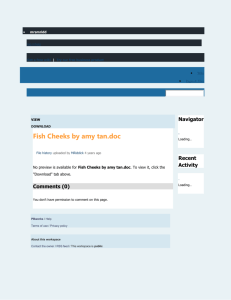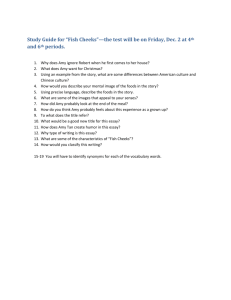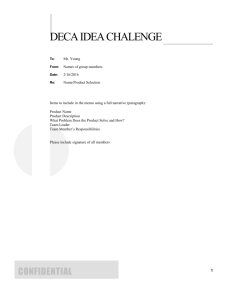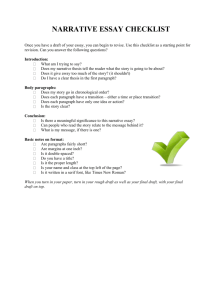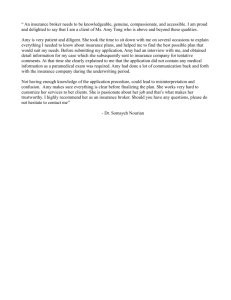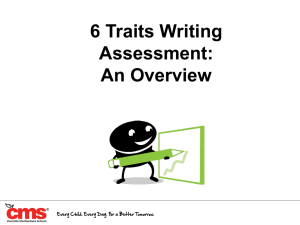Fish-Cheeks-Writing-Benchmark
advertisement
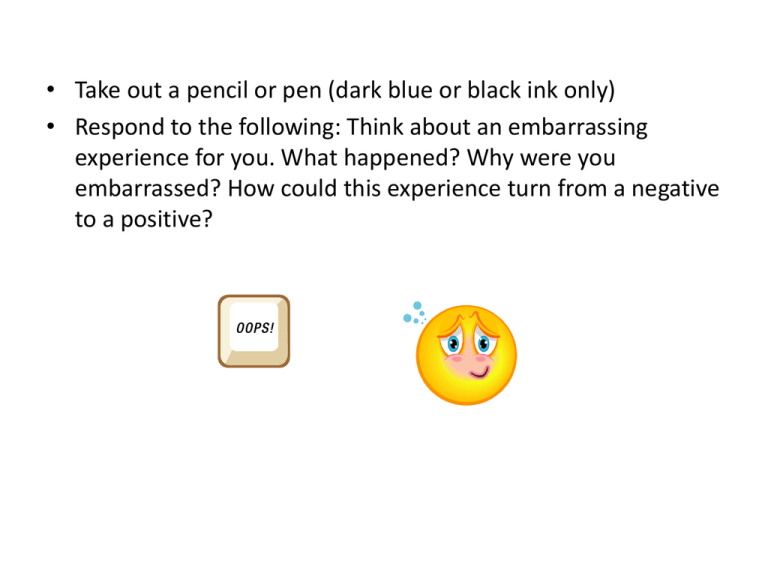
• Take out a pencil or pen (dark blue or black ink only) • Respond to the following: Think about an embarrassing experience for you. What happened? Why were you embarrassed? How could this experience turn from a negative to a positive? Narrative Writing Unit 9.W.3 Write narratives to develop real or imagined experiences or events using effective technique, well-chosen details, and wellstructured event sequences. Narrative Directions Directions: Using Tan’s essay as a model, write a brief narrative that describes a memorable childhood experience that taught you an important lesson. Pre-reading Getting ready to read Introducing key concepts Surveying the text Making predictions and asking questions Introducing key vocabulary Getting Ready to Read – Have you ever tried to hide your home language, religion or any other aspect of your family’s culture from your friends or classmates? If so, why? Describe the experience, how it felt, and what, if anything, about the situation you would change if you could. OR – Think of an occasion when, for whatever reason, you felt like you didn’t fit in. How did you react? Did you try to hide your difference in order to fit in, or did you reveal or celebrate your uniqueness? Getting Ready to Read Background Information • Christmas is not celebrated by all cultures, nor do all cultures eat the sorts of traditional foods that Americans tend to eat for their celebrations. Key Concepts • • • • Autobiography 1st person point of view Sensory detail dialogue Surveying the Text • Annotate features of the narrative essay – Title – Author – Key vocabulary • Begin responding to the following prompt: • Think about how you have many identities: What are some different “sides” you have? (e.g. your school side, your home side, your soccer side, your ethnicity, your American side, your church side, etc.) What is each one like? Have you ever been more than one at once? Describe that. Making Predictions and Asking Questions • • • • What are some of the things that good readers do before they read? Who do you think the intended audience for this piece would be? Read the first two paragraphs of “Fish Cheeks” by Amy Tan. Predict – What will this be about? Key Vocabulary Appalling – causing dismay or horror Belch - burp Astonished – sudden surprise Clamor – loud and continued noise Cod – type of fish Grimace – a facial expression that indicates disapproval Mounds – a heap Manger – a box from which cattle eat Murmur – a low continuous sound Prawns - shrimp Muster – to gather or summon Reddened – to become red Rumpled – to crush into wrinkles Tweed - a course wool cloth Shabby – showing obvious signs of wear or neglect Reading First reading (comprehension) Second reading (annotate) Third reading (purpose) Fourth reading (Looking closely at language) First Reading (Comprehension ) • Read the narrative to yourself. If you did stop, note where you lost focus. List the sequence of events in the plot. FLOW MAP Thinking Skill: Sequencing 1st thing that happened 4th thing that happened 2nd thing that happened 5th thing that happened 3rd thing that happened 6th thing that happened Second Reading (annotate) • Annotating a Text - Read With a Pen – – – – – – – Highlight main ideas C Circle powerful words or phrases Underline words or phrases you do not understand Raises a question Surprises you Make a connection Write important thoughts in the margins Third Reading (Purpose) • Check your predictions. Did you accurately predict what the story is about? • What message is the author, Amy Tan, trying to give her readers? – The message, or lesson, the author is trying to give her readers is . Create a list of times when you learned a lesson of some kind. You may end up using one of these for your narrative! Here is my sample: 1. Junk food 2. Don’t tell Kristen anything important 3. Be careful about who I lend items to 4. My brother - be careful about lending people money Fourth Reading – “Fish Cheeks” Language Text Based Questions 1. What do we learn about Amy after the first paragraph? 2. What does “pray[ing] for a slim new American nose” reveal about Amy? 3. What type of conflict does Amy experience in paragraph 2? 4. What types of diction or word choice help to convey Amy’s thoughts about the Christmas Eve dinner? (paragraph 3) 5. Cite textual evidence that support Amy’s desire to disappear (paragraph 5) 6. What does the beige miniskirt symbolize? (paragraph 7) 7. What does “your only shame is to have shame” mean? (paragraph 7) 8. What is the central idea or theme of the story? It’s your turn! Prewriting 1. What hobbies/ interests/ sports did you have as a child? 2. Have you taken a memorable vacation as a child? If so, where? 3. Is there a memorable family experience that defines you? 4. Is there a memorable school experience that defines you? 5. What event has changed your life the most? For better or worse? 6. Have you ever had to overcome some great challenge or conflict? How did you do it? What were the effects? 7. Has a member of your family ever come or gone from your life? A new sibling, the death of a grandparent or parent? 8. Have you ever voluntarily taken charge of a situation? How did it make you feel afterwards? 9. What are your major accomplishments and why do you consider them accomplishments? You do not need to write about something that you have been formally recognized for. Organizational Strategy Beginning: 1. Establish Setting (time-frame, age, season, year, place) 2. Introduce a character(s) 3. Establish Conflict - person vs. person - person vs. self - person vs. nature - person vs. society Organizational Strategy Middle: 1. Establish your sequence with the second, third, and fourth event and introduce more characters. 2. Use sensory details (Think about the food in “Fish Cheeks”) 3. Use dialogue 4. Use monologue (thoughts) Organizational Strategy End: -Discuss significance of final event -Include your thoughts -Emphasize what you learned - How are you different today because of this experience?
